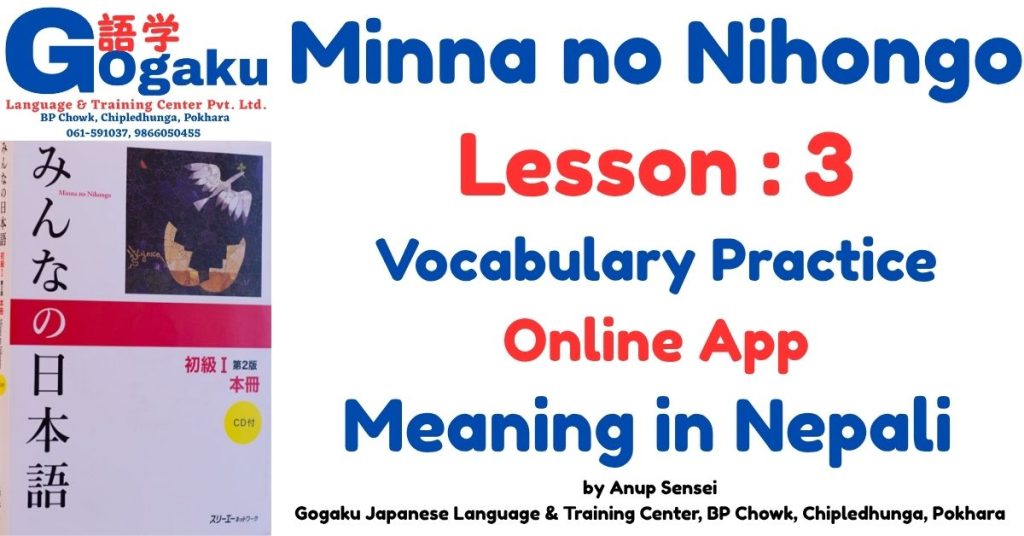JLPT N4 2013年12月 言語知識(文字・語彙)by Gogaku Pokhara
If you’re preparing for the Japanese Language Proficiency Test (JLPT), finding the right resources can make all the difference. Among all JLPT levels, N4 is one of the most important milestones, testing your foundation in vocabulary, kanji, grammar, and reading. To help students succeed, Gogaku Japanese Language & Training Center, the best Japanese language consultancy in Pokhara, has launched an exclusive JLPT N4 online practice test based on the December 2013 JLPT exam. This resource is prepared by Anup Sensei, CEO of Gogaku, who himself holds a JLPT N2 proficiency certificate. With years of experience teaching Japanese and guiding students toward JLPT and working visa success, Anup Sensei has designed this practice test to simulate the real exam experience for Pokhara’s learners and beyond. Why Gogaku’s JLPT N4 Online Practice Test Is the Best Unlike ordinary question banks, this JLPT N4 mock test offers an interactive exam-like experience that prepares you for real conditions: ✅ Real JLPT N4 Questions – 35 vocabulary and kanji questions directly from the 2013 JLPT N4 exam, ensuring authentic practice. ✅ Built-in Timer – A 30-minute countdown helps you master time management, one of the biggest challenges of the JLPT. As the time runs out, the timer changes color, simulating exam pressure. ✅ Instant Score & Feedback – Get your results immediately after submitting. You’ll see your score, percentage, and the correct answers for mistakes, ensuring faster learning. ✅ Performance Metrics Like JLPT – Results are displayed in JLPT-style scoring (out of 60 points for Vocabulary), so you can directly compare with the official passing benchmark. With this online tool, students can study smarter, not harder, identifying weak areas and practicing under real exam stress. Sections of the JLPT N4 Practice Test This JLPT N4 vocabulary and kanji practice test covers all the essential areas tested in the official exam: Kanji to Hiragana (問題1) – Choose the correct hiragana reading of kanji words in sentences. Hiragana to Kanji (問題2) – Pick the right kanji for given hiragana words. Contextual Vocabulary (問題3) – Complete sentences by selecting the most appropriate word or phrase. Synonyms & Sentence Meaning (問題4) – Match sentences with the same or similar meaning to check comprehension. Correct Word Usage (問題5) – Identify which sentence uses a given word correctly, testing advanced vocabulary application. This structure mirrors the official JLPT N4 exam, giving students in Pokhara and worldwide the closest possible practice experience. Why Choose Gogaku for JLPT Preparation in Pokhara Gogaku Japanese Language & Training Center isn’t just another institute. It is the leading Japanese language school in Pokhara, trusted by students for JLPT preparation, Japan student visas, and SSW working visas. Here’s why Gogaku stands out: 📌 Only institute in Pokhara offering interactive JLPT practice tests. 📌 Materials designed by Anup Sensei (JLPT N2 certified) with real Japanese learning experience. 📌 Complete guidance for JLPT N5, N4, N3, N2, and SSW exams. 📌 Expert consultancy for Japan student visa and working visa processing. For JLPT aspirants, Gogaku provides not only classroom training but also exclusive online study materials like this N4 practice test—resources you won’t find anywhere else in Pokhara. Start Practicing JLPT N4 Today If you’re serious about passing the JLPT N4, don’t wait. Try Gogaku’s JLPT N4 December 2013 Online Practice Test today and experience how close it feels to the real exam. With authentic questions, instant results, and JLPT-style scoring, this tool is the perfect way to measure your readiness. Combined with expert guidance from Pokhara’s best Japanese language consultancy—Gogaku, success in JLPT N4 is closer than ever. 👉 Sharpen your skills. Test your knowledge. Prepare with the best—Gogaku Japanese Language & Training Center, Pokhara. JLPT N4 (December 2013) Real Exam – Vocabulary Section
JLPT N4 2013年12月 言語知識(文字・語彙)by Gogaku Pokhara Read More »

